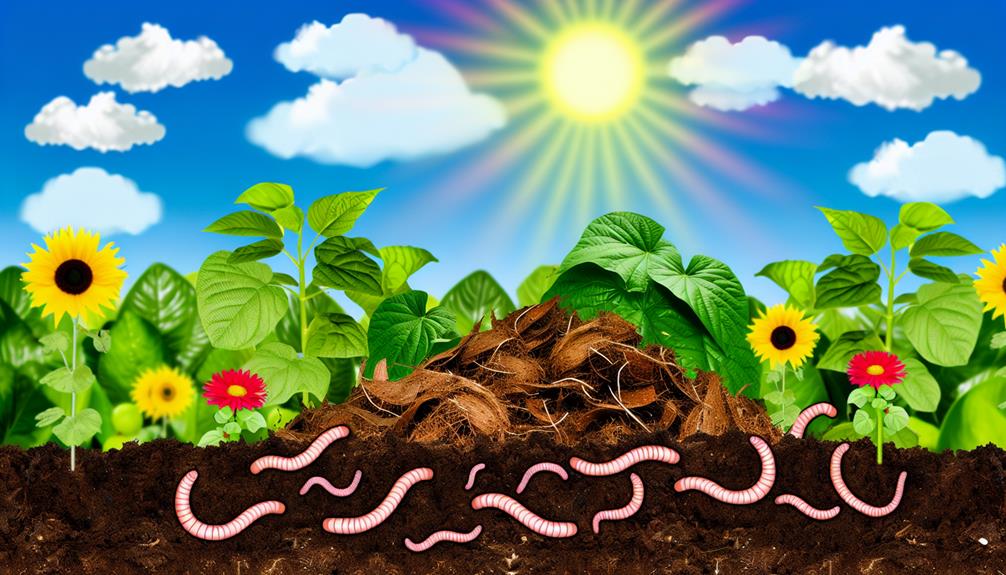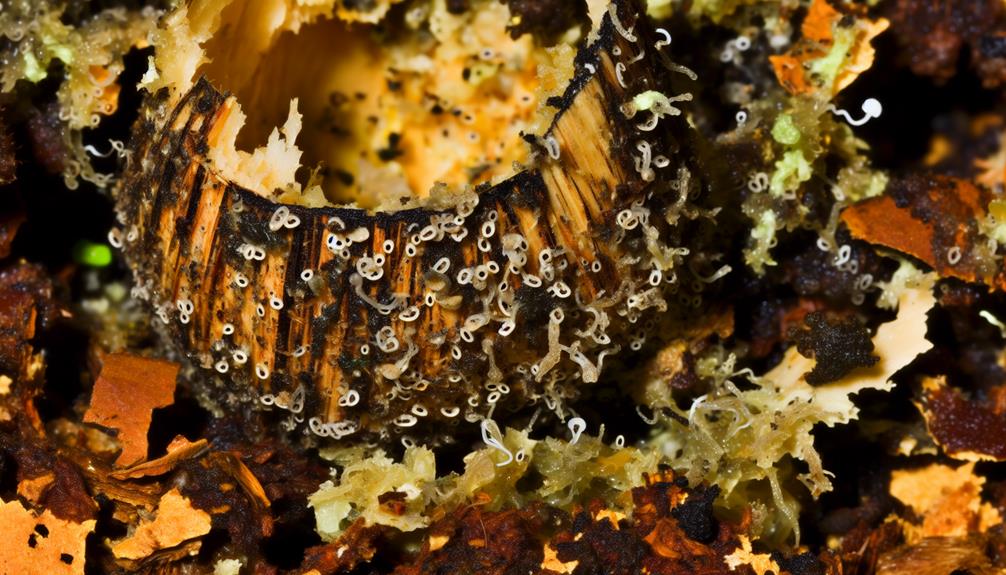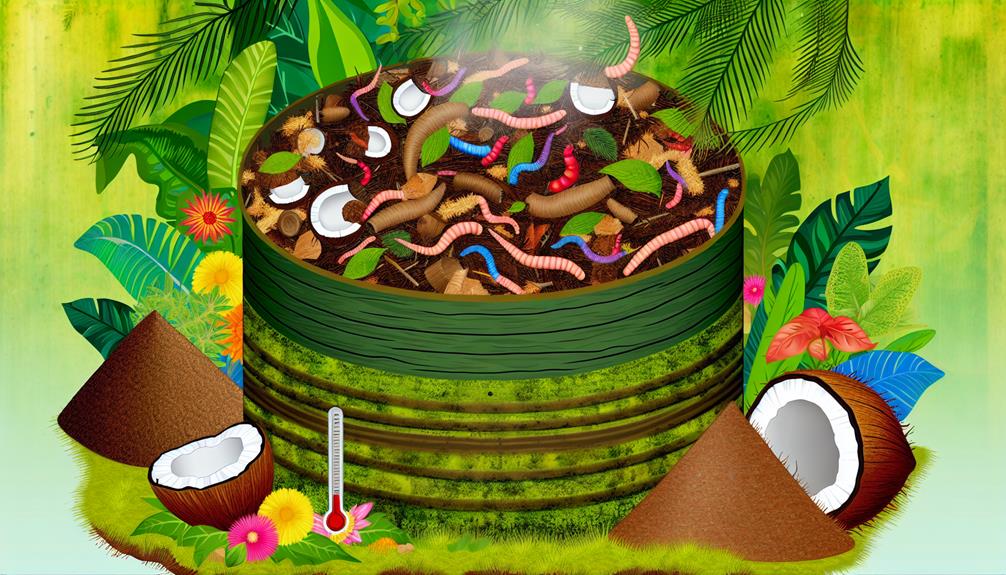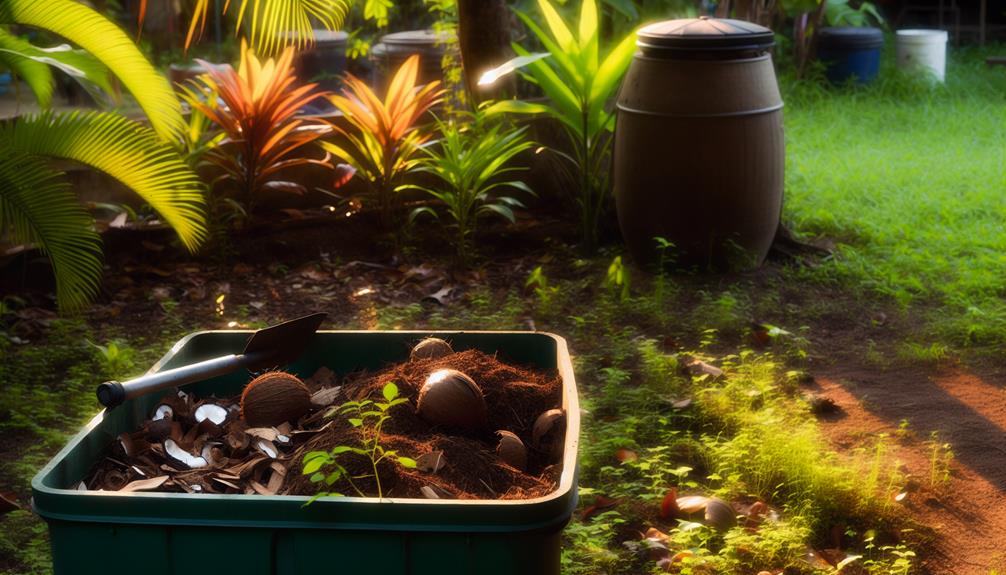

You can compost coconut shells, but they require some preparation. Since they’re composed of hard lignin and cellulose, they decompose slowly. Break the shells into smaller pieces to speed up the process, and combine them with green materials to balance the compost pile.
Regularly turn the pile and monitor moisture to help microbial activity. If you’re vermicomposting, make sure the shells are in small pieces so worms can digest them more easily. While it takes effort and time, composting coconut shells enriches soil with essential nutrients and improves its structure. Want to know more detailed methods and tips? Keep on.
Understanding the composition of coconut shells is essential to knowing how to compost them effectively. Coconut shells are primarily composed of lignin and cellulose, forming a hard and fibrous cell structure. This robust cell structure makes them challenging to break down compared to other organic materials. However, this shouldn’t deter you. With the right approach, you can successfully compost coconut shells.
To start, you need to understand the nutrient profile of coconut shells. They’re rich in carbon but low in nitrogen, which means they fall into the ‘brown’ category in composting terms. Balancing this carbon-rich material with ‘green’ nitrogen-rich materials, like fruit scraps or grass clippings, is pivotal for efficient decomposition.
Before adding coconut shells to your compost pile, it’s a good idea to break them into smaller pieces. Doing this increases the surface area, making it easier for microorganisms to do their job. You can use a hammer or a sturdy knife for this task.
Also Read: Can You Compost Wood Scraps?
By composting coconut shells, you’ll enrich your soil with essential nutrients, giving your plants a natural boost.
This process also helps reduce organic waste, making your gardening efforts more sustainable.
Additionally, composted coconut shells improve soil structure, ensuring better water retention and aeration.
Composting coconut shells greatly enhances soil nutrients, enriching your garden with essential minerals and organic matter. When you add coconut shells to your compost pile, they break down slowly, releasing important nutrients over time. This process creates a natural fertilizer that notably improves plant nutrition.
To start, crush the coconut shells into smaller pieces. This increases their surface area, speeding up decomposition. Mix these pieces thoroughly into your compost pile. The shells provide a rich source of potassium, which is vital for plant growth. They also offer trace minerals like calcium and magnesium, helping to balance soil pH and support healthy root development.
One of the key benefits of coconut shells is their high lignin content, a complex organic polymer that adds structure to your compost. This structure enhances aeration and water retention in the soil, making it more hospitable for beneficial microorganisms. These microorganisms further break down organic matter, enriching the soil even more.
Turning coconut shells into compost not only benefits your garden but also greatly reduces organic waste. By engaging in organic recycling, you contribute to a more sustainable environment. Composting coconut shells helps divert waste from landfills, leading to significant landfill reduction.
Here’s why you should consider composting coconut shells:
When you compost coconut shells, you’re not just helping your garden thrive; you’re also playing a part in reducing the overall organic waste burden. This process aligns with the principles of organic recycling, ensuring that your waste is repurposed rather than discarded.
Have you ever wondered how composting coconut shells can enhance your garden’s soil structure? When you incorporate coconut shells into your compost, they break down and contribute essential organic matter to the soil. This improves soil structure by boosting its aeration benefits and moisture retention capabilities.
First, let’s talk about aeration. Coconut shells, when composted, create small pockets of air within the soil. These pockets improve soil aeration, allowing plant roots to access oxygen more efficiently. Better aeration helps roots grow stronger and deeper, which in turn supports healthier plants.
Next, consider moisture retention. Coconut shells decompose into a fibrous material that can hold water effectively. This means your soil won’t dry out as quickly, providing a more consistent moisture level for your plants. Consistent moisture is vital for plant health, as it reduces stress and supports even growth.
Also Read: Can You Compost Cauliflower Scraps?
Despite their natural origin, coconut shells present unique challenges when you try to compost them. The hardness factor of coconut shells makes them particularly resistant to breaking down, which can greatly slow the composting process. This toughness can impede the essential microbial activity needed to decompose organic matter efficiently. Without sufficient microbial activity, coconut shells may remain in your compost pile for a prolonged period, taking up valuable space and potentially delaying the readiness of your compost.

You might feel frustrated by the persistent presence of these stubborn shells in your compost pile. Here are a few specific challenges you might face:
Understanding these challenges can make you feel more connected to a community of gardeners and composters who share your experiences. By facing these obstacles together, you can find effective solutions and improve your composting practices.
To prepare coconut shells for composting, start by thoroughly cleaning them to remove any residual flesh and fibers.
Next, break the shells into smaller pieces to accelerate the decomposition process.
Before you start composting, it’s important to clean the coconut shells thoroughly to make sure they break down efficiently. Cleaning the shells removes any residual oils and organic matter that could slow down the composting process. You’ll need a few cleaning tools and should follow safety precautions to guarantee the job is done right.
First, gather your cleaning tools: a scrub brush, mild detergent, and a bucket of warm water. Wearing gloves is a good idea to protect your hands.
Start by soaking the shells in warm water for about 20 minutes to loosen any debris.
Next, scrub the shells with the brush, using mild detergent if necessary. Ensure you rinse them well to remove any soap residue.
To connect with the community of fellow composters, remember these key points:
Once your coconut shells are clean, the next step is to break them into smaller pieces to hasten the composting process. You’ll need some cutting tools like a saw, hammer, or heavy-duty scissors. Choose tools based on what you have available and what you’re comfortable using. A saw can create more precise cuts, while a hammer may be quicker but less uniform.
Safety precautions are crucial when handling cutting tools. Wear safety gloves to protect your hands from sharp edges and splinters. Safety glasses are also a good idea to shield your eyes from flying debris. Work on a sturdy surface to guarantee stability and control.
Start by placing the coconut shell on a flat surface. If using a saw, gently saw back and forth until you break the shell into smaller sections. With a hammer, place the shell in a cloth bag to contain the pieces, and then tap it until it breaks. For scissors, cut along the edges carefully.
Breaking the coconut shell into pieces about the size of a coin will help it decompose faster in your compost pile. Properly prepared, these pieces will blend well with other compost materials.
Balancing the carbon-nitrogen ratio in your compost is important for efficient decomposition, and coconut shells, being high in carbon, play an important role in this balance. To achieve the ideal ratio, you need to mix these high-carbon materials with nitrogen-rich green materials. This combination encourages microbial activity, speeding up the composting process.
To incorporate coconut shells effectively, remember to:
Balancing carbon and nitrogen is important. Coconut shells, while excellent for adding carbon, need to be balanced with nitrogen sources to prevent the compost from becoming too dry and slow to break down. Green materials like kitchen scraps and fresh yard waste offer the necessary nitrogen.
Also Read: Can You Compost Cedar Chips?
To speed up the decomposition of coconut shells, you can start by breaking them into smaller pieces. This increases the surface area, allowing for an accelerated breakdown. Smaller pieces are more accessible to microbial activity, which is essential for effective composting. Use a hammer or another tool to break the shells into manageable fragments before adding them to your compost pile.

Another method to hasten decomposition is to soak the coconut shells in water for a few days. Moisture softens the shells, making it easier for microbes to break them down. After soaking, drain the excess water and add the softened shells to your compost.
Regularly turning your compost pile also helps. By mixing the contents, you make sure that oxygen is evenly distributed, which boosts microbial activity. Aerobic bacteria, which thrive in oxygen-rich environments, play an important role in decomposing tougher materials like coconut shells.
Additionally, adding a compost accelerator or activator can be beneficial. These products contain enzymes and beneficial microbes that enhance the composting process. Incorporate the accelerator according to the package instructions for best results.
Guaranteeing your compost pile has the right balance of greens and browns is crucial for efficient decomposition. Greens, like vegetable scraps and grass clippings, provide nitrogen, while browns, such as dry leaves and coconut shells, supply carbon. The key to a healthy compost pile lies in proper compost layering and maintaining the right compost moisture level.
To achieve this balance, follow these steps:
Incorporating coconut shells in vermicomposting can greatly enhance the nutrient content and structure of your compost. Start by breaking the shells into smaller pieces to make them more accessible for the worms. Worms prefer bedding materials that are easy to digest, so pre-soaking the shells in water for a few days can also help soften them.
When setting up your worm bin, mix the coconut shell pieces with other bedding materials like shredded paper, cardboard, or dried leaves. This combination provides a balanced habitat for your worms, ensuring they’ve both carbon-rich and nitrogen-rich materials to process.
As the coconut shells break down, they add valuable organic matter to the compost, improving its texture and nutrient profile. Worms particularly benefit from the aeration that the shells provide, as it enhances their living conditions by preventing compaction in the bedding.
Monitor the moisture levels in your bin, as coconut shells can absorb water and may require occasional rehydration. By carefully incorporating coconut shells into your vermicomposting system, you create an enriched environment that enhances worm activity and produces high-quality compost. This practice not only benefits your garden but also helps you connect with sustainable living practices.
Coconut shells offer a myriad of alternative uses, turning what might be waste into valuable resources. You can transform these shells into craft projects and garden decorations, adding a touch of creativity and sustainability to your home and garden.
Here are some ideas to get you started:
Also Read: Can You Compost Broad Beans?
Embracing the practice of composting coconut shells not only enriches your soil but also promotes a sustainable lifestyle. By integrating coconut shells into your composting routine, you’re reducing waste and contributing to a healthier planet.

Coconut shells are rich in lignin, which breaks down slowly, providing long-term benefits to your compost. For the best results, break the shells into smaller pieces before adding them to your compost pile. This accelerates decomposition and guarantees a more uniform mixture. Remember, patience is key—coconut shells take longer to break down compared to other organic materials.
Besides composting, consider using coconut shells in crafting projects or as unique decoration tips. They make excellent natural planters or can be transformed into decorative items like bowls or candle holders. These alternative uses not only enhance your home’s aesthetic but also align with eco-friendly practices.
Coconut shells can take several years to decompose in a compost pile. The decomposition process is slow, but the nutrient breakdown will eventually enrich your compost. Patience and persistence are key to being part of this eco-friendly community.
Yes, you can use composted coconut shells for indoor plants. They enhance nutrient distribution and improve moisture retention. By doing this, you’ll create a thriving environment for your plants and join a community of eco-conscious gardeners.
Yes, some pests might be attracted to composting coconut shells. To guarantee pest prevention, you can use natural deterrents like neem oil or citrus peels. This way, you’ll maintain a healthy and welcoming composting environment.
When you compost coconut shells, they don’t notably alter soil acidity. They break down slowly, supporting steady microbial activity. You’ll find your compost community remains balanced, fostering a sense of belonging for all organic matter involved.
You can compost coconut shells in a city composting program, but it depends on city regulations and collection methods. Check your local guidelines to make sure you’re following the rules and contributing to a greener community together.
Composting coconut shells is a practical way to reduce waste and enrich your soil. Make sure you break them into smaller pieces to speed up decomposition.
Balance your compost pile with greens and browns, and consider vermicomposting for added benefits.
If composting isn’t feasible, look into alternative uses like garden mulch or craft projects.
By following these tips, you’ll effectively turn coconut shells into a valuable resource for your garden.
